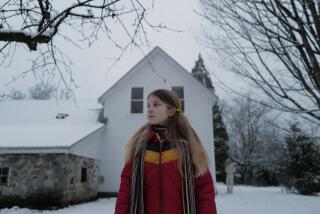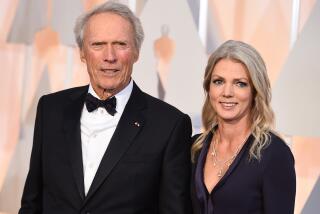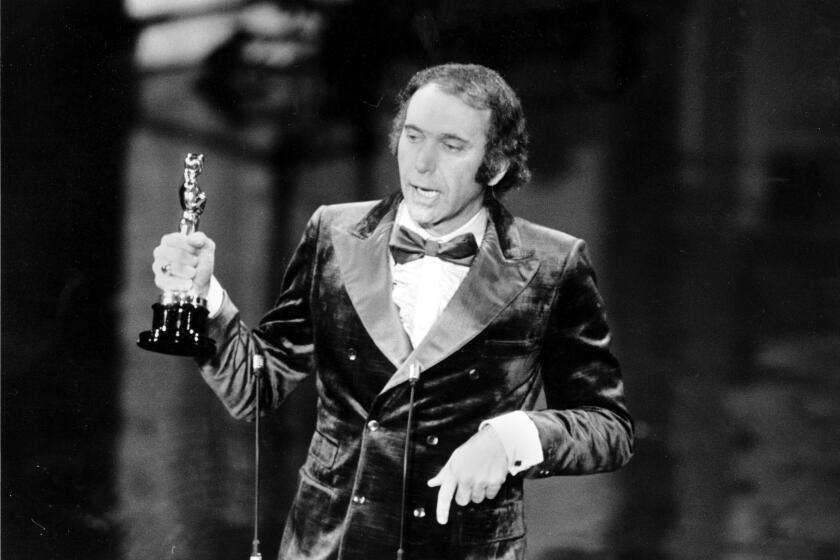Of Human Bonding
Roll 4, Take 2. Glenn Close is playing Elaine, a doctor. She opens the door of her spacious English-style house to Calista Flockhart, who is Christine, an out-of-work actress who reads Tarot cards for a living. She’s here to help Elaine wrestle with some thorny problems--a dying mother and an unrequited love.
It’s the beginning of a long day of shooting in this Hancock Park location of a new, low-budget but star-studded film, “Things You Can Tell Just by Looking at Her,” scheduled for release by United Artists next year.
For the record:
12:00 a.m. Nov. 7, 1999 For the Record
Los Angeles Times Sunday November 7, 1999 Home Edition Calendar Page 119 Calendar Desk 2 inches; 40 words Type of Material: Correction
“Things” caption--Amy Brenneman, not Mika Boorem, was pictured with Cameron Diaz in a photo accompanying last week’s article about “Things You Can Tell Just by Looking at Her.” Also, a quote about Glenn Close joining the film’s cast should have been attributed to producer Jon Avnet.
The women eye each other. Flockhart, her hair a mass of tousled ringlets, dressed in a skimpy top and filmy floral skirt, is quite different from Close, who’s very much the cool professional in her white linen pantsuit. Cut. Close isn’t happy with their brief exchange--Christine introduces herself as a friend of a friend. “What stops me is how she looks,” Close muses. “And I’m saying, ‘Yes, of course.’ It doesn’t make sense.”
Much discussion ensues among the actors; Jon Avnet, the producer; and Rodrigo Garcia, the writer-director, a first-time filmmaker who developed the script in a Sundance Institute workshop with the help of Avnet, a veteran of films about women (“Fried Green Tomatoes,” and the TV movie “The Burning Bed” with Farrah Fawcett). Finally, everyone agrees it makes more sense for Close to say simply, “Yes, come in.”
A small matter, perhaps, but typical of this quietly powerful film in which a nuanced look or a casual word speaks complicated volumes, and in which nothing is quite what it seems--even the title. Though called “Things You Can Tell Just by Looking at Her,” the film actually focuses on things you can’t tell about people just by looking at them, the behind-the-scenes aspects of people’s lives--in fact, five sets of lives that intersect, but only tangentially, underscoring the film’s other major theme, the difficulty people have in making emotional connections.
“It’s basically about people just trying to deal with life,” Close says, taking a 15-minute break from the set for a touch-up by a makeup artist. “And I always find that very moving. It’s like painting with a fine brush, emotionally.”
Featuring a high-profile, mostly female cast--Close, Flockhart, Holly Hunter, Cameron Diaz, Amy Brenneman, Valeria Golino, Kathy Baker and Irma St. Paule--the film tries to capture life in all its intricacy by presenting women of different ages and socioeconomic statuses--from a doctor to a homeless woman--and in a range of relationships, between men and women, lesbians, sisters, a woman and her aging mother, a mother and her teenage son, even neighbors. There are also several respected male actors, including Matt Cravens and Miguel Sandoval. For Close, it’s been an “insecure” day, she says, partly because she merely has to sit and listen while Flockhart as Christine makes a long speech about Elaine’s problems as she sees them in the cards.
The question is: How much would this apparently self-possessed, professional woman--who’s nevertheless desperate enough to seek knowledge of her future through fortunetelling--reveal about herself through gestures and facial expressions? “We did versions of showing different things, letting the pain show through sometimes, and then not letting it show through,” explains Close.
People’s reactions are spontaneous, she adds, “but they are informed by who they are and the accumulation of their experience, so a simple action becomes very telling. It’s what’s fascinating to me as an actor.”
All the actors were drawn to the script by what Close calls its very rich writing and its honesty about women--”a bunch of very varied and real and specific women.”
“I read it once and said, ‘I’m going to do this,’ ” Close says. Typical of the script’s emotional complexity is a moment when Elaine is trying to feed her ailing, mentally absent mother with a spoon. Suddenly, her mother is present, looking at her daughter, as if to say, “ ‘I’m sorry it’s come to this. I’m sorry that you have to feed me and change my diapers.’ She’s reaching out to me with her eyes, but I don’t see it,” Close says. Even though Elaine loves her mother, she’s absorbed in her own world, “concentrating on, ‘Why didn’t that man call?’ ”
“The script is so beautiful and descriptive, it’s like reading a novel,” says Diaz (“There’s Something About Mary”), who plays Carol, a young, pretty yet cynical blind woman who’s also a hopeless romantic--a role she researched by spending time at the Braille Institute in Los Angeles. “It’s also the kind of story you never usually see, about women in their private moments. And it’s honest about what the characters are going through. It’s very touching; it reaches you.” Her character lost her sight around the age of 15, “a shattering thing,” Diaz says, “like dealing with the death of someone close to you. You go through grievance, denial, depression, and then you come to a point where you deal with that. Carol has a good sense of herself.”
Typical are Carol’s two powerful speeches about women’s lives. One lists all the things “women get tired of doing. They get tired of phone calls that never come, the promises that are never kept, running into dead ends.” The other addresses the death of a child and the pain that one experiences from loss.
Diaz also likes the fact there’s no real happy ending to the film, though it’s “compassionate about women,” and their lives do move forward. Her character, who “goes through men like toothpicks because she’s afraid none of them will stick, . . . makes a huge leap by being honest with herself,” she says.
*
Hunter’s character, Rebecca, who’s having an affair with a married man, simply doesn’t open the door to him one day. For Flockhart, who plays a lesbian whose partner, Lilly (Golino), is dying of cancer, it was the “love story” aspect that grabbed her, and how difficult it is to watch someone you love die slowly. “This film doesn’t make apologies,” she says. “It’s real; it’s not cliched.” For example, her character’s sense of distance from her dying lover has the ring of truth. “The irony is, although Lilly is the one who’s dying, Christine is dying herself a bit, too,” Flockhart says. “I think she’s full of fear. She wants Lilly to hurry up and go. She’s taken care of her, and she resents her, and yet she’s ashamed. She’s very in love with Lilly but angry with her for leaving.”
St. Paule, who plays Elaine’s eightysomething senile mother, thought the script presented sensitive portrayals of all kinds of women. “And that a man wrote it makes it more interesting,” she adds. “I was taken aback when I first saw the author, until I realized he’s very special. He’s a very masculine man but really open to women.”
Everyone involved in this film has a sense of mission about promoting a project that explores human behavior in an intelligent, compassionate manner. It’s scripts like this, Close says, that allow her to say, “This is why I’m an actress.”
Avnet first read the script on the plane to Sundance in 1998. “My first reaction was, ‘God, it’s an amazing script about women,’ ” Avnet says over lunch in his trailer on the Hancock Park set. At Sundance, he met writer Garcia, a Mexican-born photographer who studied at the American Film Institute in Los Angeles. Garcia had worked as director of photography on “Mi Vida Loca,” an independent film by Allison Anders, but had never directed a film of his own. Working with Garcia on the script at Sundance, Avnet was “impressed with his precision, his specificity, and also the fact that he was clearly comfortable on his feet, because most first-time writer-directors have little or no experience on the set. So at that point, I made the foolhardy offer to finance the film,” he adds with a grin.
The script had already been turned down by several studios. “People liked it,” Garcia says, “but the comment was always, ‘We don’t know what to do with it--what else do you have?’ ” But Avnet had already made a decision to be a “patron” to young writer-directors of serious work, a sort of counter-programming to action movies.
“The turning point was when Glenn [Close] came aboard,” Garcia says. Hunter followed suit, then Baker, and then, “at that point, the script became a little bit of a phenomenon,” he said. After Flockhart agreed to be in the movie--he calls her an actor with tremendous range, who could be “the next Jessica Tandy”--Avnet pursued Diaz, as “‘someone whose star is rising and who’s got these beautiful blue eyes, and so for her to play a blind woman is really interesting.”
The film has a good shot at success, he says, not only because “the pedigree is impeccable” but also because “there’s nothing like it. It’s true to the world; it really is. And it’s a tough world, but in that toughness there is beauty.”
More to Read
Only good movies
Get the Indie Focus newsletter, Mark Olsen's weekly guide to the world of cinema.
You may occasionally receive promotional content from the Los Angeles Times.






